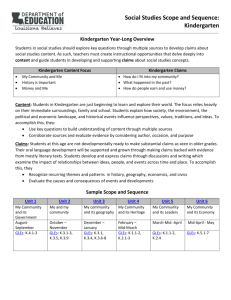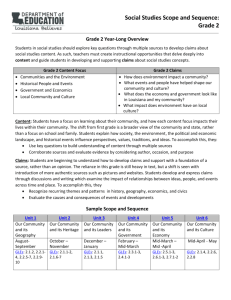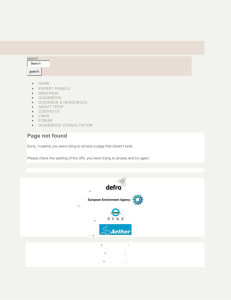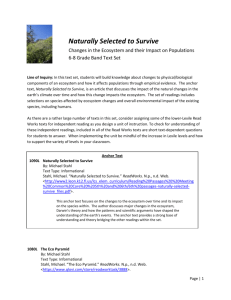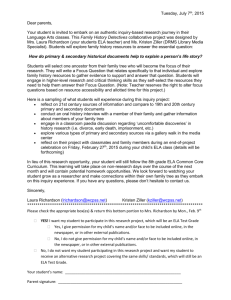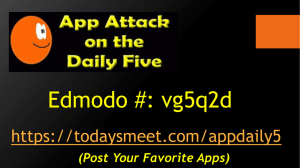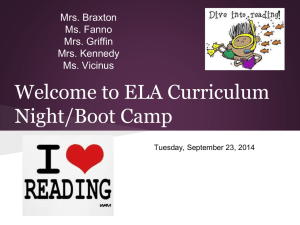Social Studies Sample Scope and Sequence - Grade 1
advertisement
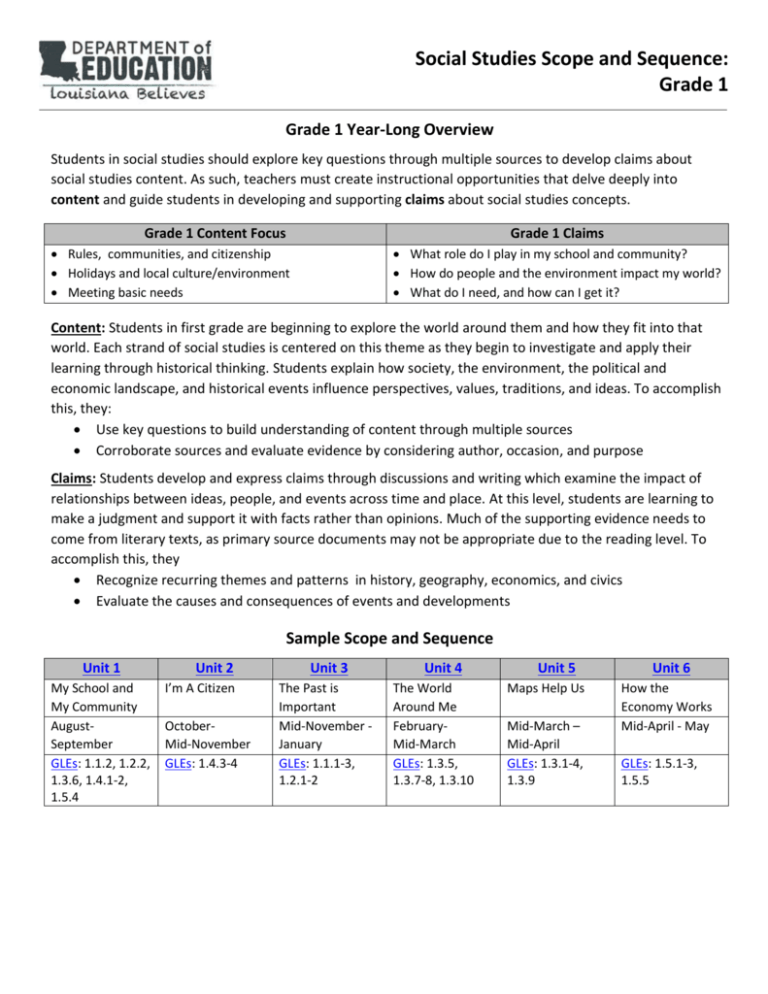
Social Studies Scope and Sequence: Grade 1 Grade 1 Year-Long Overview Students in social studies should explore key questions through multiple sources to develop claims about social studies content. As such, teachers must create instructional opportunities that delve deeply into content and guide students in developing and supporting claims about social studies concepts. Grade 1 Content Focus Grade 1 Claims Rules, communities, and citizenship Holidays and local culture/environment Meeting basic needs What role do I play in my school and community? How do people and the environment impact my world? What do I need, and how can I get it? Content: Students in first grade are beginning to explore the world around them and how they fit into that world. Each strand of social studies is centered on this theme as they begin to investigate and apply their learning through historical thinking. Students explain how society, the environment, the political and economic landscape, and historical events influence perspectives, values, traditions, and ideas. To accomplish this, they: Use key questions to build understanding of content through multiple sources Corroborate sources and evaluate evidence by considering author, occasion, and purpose Claims: Students develop and express claims through discussions and writing which examine the impact of relationships between ideas, people, and events across time and place. At this level, students are learning to make a judgment and support it with facts rather than opinions. Much of the supporting evidence needs to come from literary texts, as primary source documents may not be appropriate due to the reading level. To accomplish this, they Recognize recurring themes and patterns in history, geography, economics, and civics Evaluate the causes and consequences of events and developments Sample Scope and Sequence Unit 1 My School and My Community AugustSeptember GLEs: 1.1.2, 1.2.2, 1.3.6, 1.4.1-2, 1.5.4 Unit 2 I’m A Citizen OctoberMid-November GLEs: 1.4.3-4 Unit 3 The Past is Important Mid-November January GLEs: 1.1.1-3, 1.2.1-2 Unit 4 The World Around Me FebruaryMid-March GLEs: 1.3.5, 1.3.7-8, 1.3.10 Unit 5 Maps Help Us Mid-March – Mid-April GLEs: 1.3.1-4, 1.3.9 Unit 6 How the Economy Works Mid-April - May GLEs: 1.5.1-3, 1.5.5 Social Studies Scope and Sequence: Grade 1 Unit 1: My School and My Community (August–September) Unit overview: In this unit students explore the necessity of rules, jobs in their community, and what makes their community special. This sets the stage for the unit to follow where students explore what it means to be a citizen of a community. Note: This content can be taught in conjunction with the Duck for President unit (Lesson 1) and Amelia Bedelia unit (Lesson 9) from the English Language Arts Guidebook for Grade 1. Topic and Days Content and Claims Community Structure How do rules help us? (1.4.1) What is the purpose of rules/laws at home, at school, and in the community? (1.4.2) What jobs and industries can be found within the school and community and how they benefit the school and community? (1.5.4) Why are local traditions/celebrations, customs, languages and foods important? (1.2.2, 1.3.6) 10 days Community Helpers 10 days Community and Culture 10 days Possible Sources Possible Sources School Rules Miss Nelson is Missing, Harry Allard and James Marshall “Why Do We Need Rules?,” ReadWorks Text from ELA Guidebook Unit: o If Everybody Did, Jo Ann Stover Possible Sources My School Community, Bobbie Kalman What Do People Do All Day?, Richard Scarry Community Helpers, World Book’s Learning Ladders Helpers in My Community, Bobbie Kalman “A Community of People,” ReadWorks Community Helpers, Scholastic (eBooks) How People Make Things (video) Mr. Rogers’ Neighborhood Who are the People in your Neighborhood?, YouTube Text from ELA Guidebook Unit: o Community Helpers from A to Z, Bobbie Kalman Possible Sources Our National Holidays, Karen Bornemann Spies Celebrate Holidays Around the World, Laurie Rozakis Louisiana Festivals, Louisianatravel.com Social Studies Scope and Sequence: Grade 1 Unit 2: I’m a Citizen! (October–Mid-November) Unit overview: In this unit students explore what it means to be a citizen in the classroom, school and community. They also examine and learn about leaders and the roles they have. This sets the stage for the unit to follow where students explore events and people from the past and how important events and leaders have impacted their lives today. Note: This content could be taught in conjunction with the Duck for President unit (Lessons 2, 3, 6, and 8) from the English Language Arts Guidebook for Grade 1. Topic and Days Content and Claims Citizenship and Leadership 30 days What are the roles, rights, and responsibilities of a citizen of the class, school, and community? (1.4.4) Who are the current political leaders of the community, state, and country? (1.4.3) Possible Sources Possible Sources The Berenstain Bears: Trouble at School , Stan and Jan Berenstain (Part 1, Part 2) The Berenstain Bears and The Big Election, Stan and Jan Berenstain What Does the President Do?, Scholastic (eBook) Electing our Leaders, Earl McGraw Texts from ELA Guidebook Unit: o Duck for President, Doreen Cronin o Being a Leader, Robin Nelson o We Live Here Too: Kids Talk about Good Citizenship, Nancy Loewen Social Studies Scope and Sequence: Grade 1 Unit 3: The Past is Important (Mid-November–January) Unit overview: In this unit students explore events and people from the past and how important events and leaders have impacted their lives, with an emphasis on national holidays. This sets the stage for the unit to follow where students explore how the environment and world impacts their life. Topic and Days Content and Claims Past and Present 15 days American Symbols How can we show the events of our lives in chronological order? (1.1.2) How are lifestyles from the past the same and different from lifestyles of today? (1.1.1, 1.1.2, 1.1.3) Possible Sources Infographic on technology then/now “How Did Pilgrim Children Live?,” ReadWorks “Horses, Carriages, and Wagons,” ReadWorks The House on Maple Street, Bonnie Pryor Now & Then, Liberty’s Kids Text from ELA Guidebook Unit, Grade 2 o Window, Jeannie Baker Why are American heroes, symbols, landmarks, and patriotic songs important? (1.2.1) Why do we celebrate events commemorated by national holidays? (1.2.2) Possible Sources “A Star-Spangled Song,” ReadWorks “A Great Statue,” ReadWorks Why are there Stripes on the American Flag?, Martha Rustad Can We Ring the Liberty Bell?, Martha Rustad Why is the Statue of Liberty Green?, Martha Rustad Can you Sing “The Star-Spangled Banner?”, Martha Rustad Is a Bald Eagle Really Bald?, Martha Rustad O, Say Can You See?, Sheila Keenan Liberty Bell, Ben’s Guide Texts from ELA Guidebook Unit, Kindergarten: o America the Beautiful, Katharine Lee Bates o America Is…, Louise Borden o “America the Beautiful” (audio) o U.S. Symbols, BrainPOP Jr. Possible Sources The First Thanksgiving, Scholastic “Celebrate Flag Day,” ReadWorks “President’s Day,” ReadWorks 4th of July, Time for Kids 5 days Recognizing Historical Events 15 days Possible Sources Social Studies Scope and Sequence: Grade 1 Unit 4: The World Around Me (February–Mid-March) Unit overview: In this unit students explore how the environment and world impacts their life and the lives of others. They learn how people use and impact the environment. This sets the stage for the unit to follow where students explore landforms and map skills. Topic and Days Content and Claims The Environment Impacts People 15 days People impact their Environment 15 days How do the seasons impact daily activities in various regions? (1.3.5) In what ways do people rely on the environment to meet their basic needs? (1.3.7) How does environment determine various types of human shelters? (1.3.8) How do people impact the environment (1.3.10) Possible Sources Possible Sources On the Same Day in March: A Tour of the World’s Weather, Marilyn Singer Four Seasons, NeoK12 All Kinds of Homes, Emma Damon How We are Sheltered Food Crops, National Geographic Texts from ELA Guidebook, Grade 2: o Excerpts from Children from Australia to Zimbabwe: A Photographic Journey around the World, Maya Ajmera and Anna Rhesa Versola o Excerpts from If You Lived Here: Houses of the World, Giles Laroche Possible Sources “A Clean Drink of Water,” ReadWorks “Garbage in the Ocean,” ReadWorks Where Have all the Pandas Gone?, Melvin & Gilda Berger Keeping our Earth Green, Nancy F. Castaldo “Rachel Carson’s Gift”, National Geographic Young Explorer, April 2010, pages 16-23 Social Studies Scope and Sequence: Grade 1 Unit 5: Maps Help Us (Mid-March–Mid-April) Unit overview: In this unit students explore landforms and basic map skills. They gain an understanding of how to read maps, and the use of maps in their community and world. Topic and Days Content and Claims Maps and Globes 20 days How do you use the different parts of a map? (1.3.1, 1.3.2) How do you create a map of a place? (1.3.3) How are different landforms shown on a map/globe? (1.3.4) How can you locate your town, parish, state, and country on a map? (1.3.9) Possible Sources Possible Sources “The Difference between Maps and Globes,” ReadWorks “How to Draw a Map,” ReadWorks As the Crow Flies, Gail Hartmand and Harvey Stevenson Interactive map of US - landforms, Eduplace National Park Service Map tutorial “All Kinds of Maps,” ReadWorks Social Studies Scope and Sequence: Grade 1 Unit 6: How the Economy Works (Mid-April–May) Unit overview: In this unit students explore basic economic principles of saving versus spending and goods/services. This final unit sets the stage for second grade to follow where students further develop all skills in more depth and detail. Topic and Days Content and Claims Saving and Spending Money How can people save money? (1.5.1) How do you know if something is a need or a want? (1.5.2) Possible Sources The Berenstain Bears’ Trouble with Money, Stan and Jan Berenstain Sheep in a Shop, Nancy Shaw A Chair for My Mother, Vera B. Williams Piggy Bank Primer, Federal Reserve Bank of St. Louis Text from ELA Guidebook, Grade 2: o My Rows and Piles of Coins, Tololwa Mollel What is the difference between a good and a service? (1.5.3) How can people get goods and services? (1.5.5) Possible Sources Needs and Wants, Social Studies for Kids Goods and Services at a Veterinarian Clinic, Council for Economic Education Text from ELA Guidebook, Grade 2: o Who’s Buying? Who’s Selling?: Understanding Consumers and Producers, Jennifer S. Larson 10 days Goods and Services 10 days Possible Sources 2011 Social Studies Grade-Level Expectations: Grade 1 History Standard 1 – Historical Thinking Skills Students identify concepts of continuity and change in their personal environments. 1.1.1 Construct personal timelines that highlight past and present events 1.1.2 Create a primary source of personal information 1.1.3 Compare and contrast lifestyles of the past to the present Standard 2 – Historical People, Events, and Symbols Students identify and describe people, events, and symbols that are important to the United States. 1.2.1 Identify and explain the importance of American heroes, symbols, landmarks, and patriotic songs 1.2.2 Describe reasons for celebrating events commemorated in national holidays Geography Standard 3 – Maps, Globes, and Environment Students recognize and use basic geographic tools to organize and interpret information about people, places, and environments. 1.3.1 Identify a representation of a location/space on a map/globe 1.3.2 Identify simple map symbols, compass rose (cardinal directions), and key/legend 1.3.3 Use mental mapping (visualizing details of a place or location out of one’s sight) to develop a basic map of local places 1.3.4 Identify basic landforms using a globe or map 1.3.5 Describe the impact that seasons have on daily activities and on the physical environment in various regions 1.3.6 Compare and contrast local traditions/celebrations, customs, languages, and foods as an introduction to culture 1.3.7 Explain ways in which people rely on the environment to meet the basic human needs of food, clothing, and shelter 1.3.8 Describe how the environment determines various types of human shelters 1.3.9 Identify by name the town/city, parish, state, and country in which the student lives 1.3.10 Predict ways human actions impact the environment 2011 Social Studies Grade-Level Expectations: Grade 1 Civics Standard 4 – Government and Citizenship Students develop an understanding of the purpose and structure of government and their role as a responsible citizen. 1.4.1 Develop a list of rules for the classroom and describe their benefits/consequences 1.4.2 State examples of rules and laws in the home, school, and community and explain their purposes 1.4.3 Identify the current mayor, governor, and president 1.4.4 Describe the student's role, rights, and responsibilities as a citizen of the class, the school, and the community Economics Standard 5 – Basic Economic Concepts Students explain the economic concepts of goods and services within their school and community. 1.5.1 Identify ways to save money 1.5.2 Distinguish between needs/wants of people by responding to real life situations 1.5.3 Distinguish between goods and services 1.5.4 Identify jobs and industries within the school and community 1.5.5 Identify ways people exchange/trade goods and services
